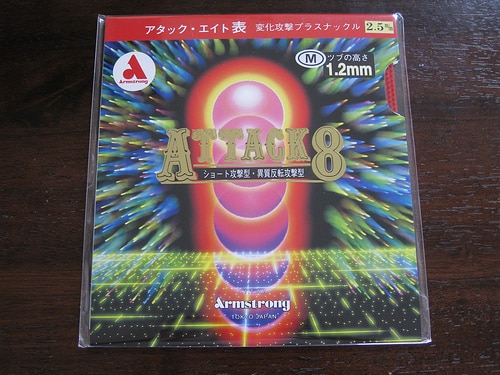Armstrong’s
I haven’t seen many Armstrong rubbers advertised in the United States, but one of my good friends swears by the Armstrong Attack 8. She’s a chopper type player, called a “cut man” in Japanese, and likes how this particular
Table of Contents
ToggleArmstrong Attack 8 Type M

She is planning on using the Armstrong Attack 8 with Tackifire that I reviewed before.
The type M shown here has the 1.2mm pips. There is also an L version with slightly longer pips.
I’ve always liked Armstrong rubbers, and I hope they catch on a little more in the US!
For the brand Armstrong, some people find that everything is at the highest level.
My friend placed this
She found that sometimes she has a problem receiving the ball in low bounce with the chop to make it just over the net to the opponent’s side. So she changed to a softer carbon blade, which is Stiga Offensive Classic Carbon. It seems like a good choice for her as she can now get reasonable control of the ball.
My Experience
I have tried to play the game with the Armstrong Attack 8 Type M
After a few strokes, I found that the trajectory that the blade generated is relatively flat. It won’t make a great arc from your shot. The hitting pace is just nice, and you do not need too much strength to hit the ball.
By having this
The trajectory is flat, and it won’t make a great arc from your shot. The hitting pace is just nice.
Does the Color of Table Tennis Rubber Affect Its Properties?
It is a question I also had when I started looking for the kind of table tennis
That brings us to the scientific question of whether the color (or the coloring) of the table tennis rubbers changes it at all…
According to Butterfly Japan’s FAQ, the answer is that there is no difference between the black and red rubbers. When tested in the factory, they all produce the same results.
However, in Japan, players often say they feel that black table tennis
To sum up, the official word is that there is no difference between black and red table tennis rubbers, although some players say they feel and affect the ball differently.
Rating of the Rubber :
- Speed: 7.1
- Spin: 5.8
- Control: 7.8
Armstrong Attack 8 Type L
This
By having this
The Armstrong 8 Attack Type L with a 1.8mm sponge is good at blocking and counter-attacking.
You can try to place this
The
well.
If you play with this
If you are playing defense in mid-distance, you can perform an attack anytime you get a chance. You can also play sidespin with your backhand, and this
Conclusion
The pip of Armstrong Attack L is small, thin, straight, and indeed sticky. It is perfect for pushing the ball but with low speed and control. The
These are the 2 types of rubbers that I have tried. Today I will brief you on the feeling of using them, and I hope this can help the players who use these rubbers.
I am not writing them in very detailed because the blades used by all players are different, so the feeling of the sponge will be different. However, the actual performance will be the same.
Another reason is that the technical movements of different players will have different feelings on the
The third reason is that I have some description of the
Whether the
For the Japanese Armstrong’s ATTACK
I think the most significant advantage of Japanese rubbers is their sponge. They are very soft, very elastic, good strength, reasonable control, and feel very good.
Advice About Trying Table Tennis Rubber with Pips

Warren Davies
Hi, I’m Warren Davies, a table tennis addict who loves sharing tips, reviews, and everything you need to level up your game. I’ve spent years playing, testing gear, and geeking out over the sport, and I’m here to make things simple and fun for players of all levels. When I’m not writing, you’ll probably find me perfecting my forehand or trying out the latest paddle.








